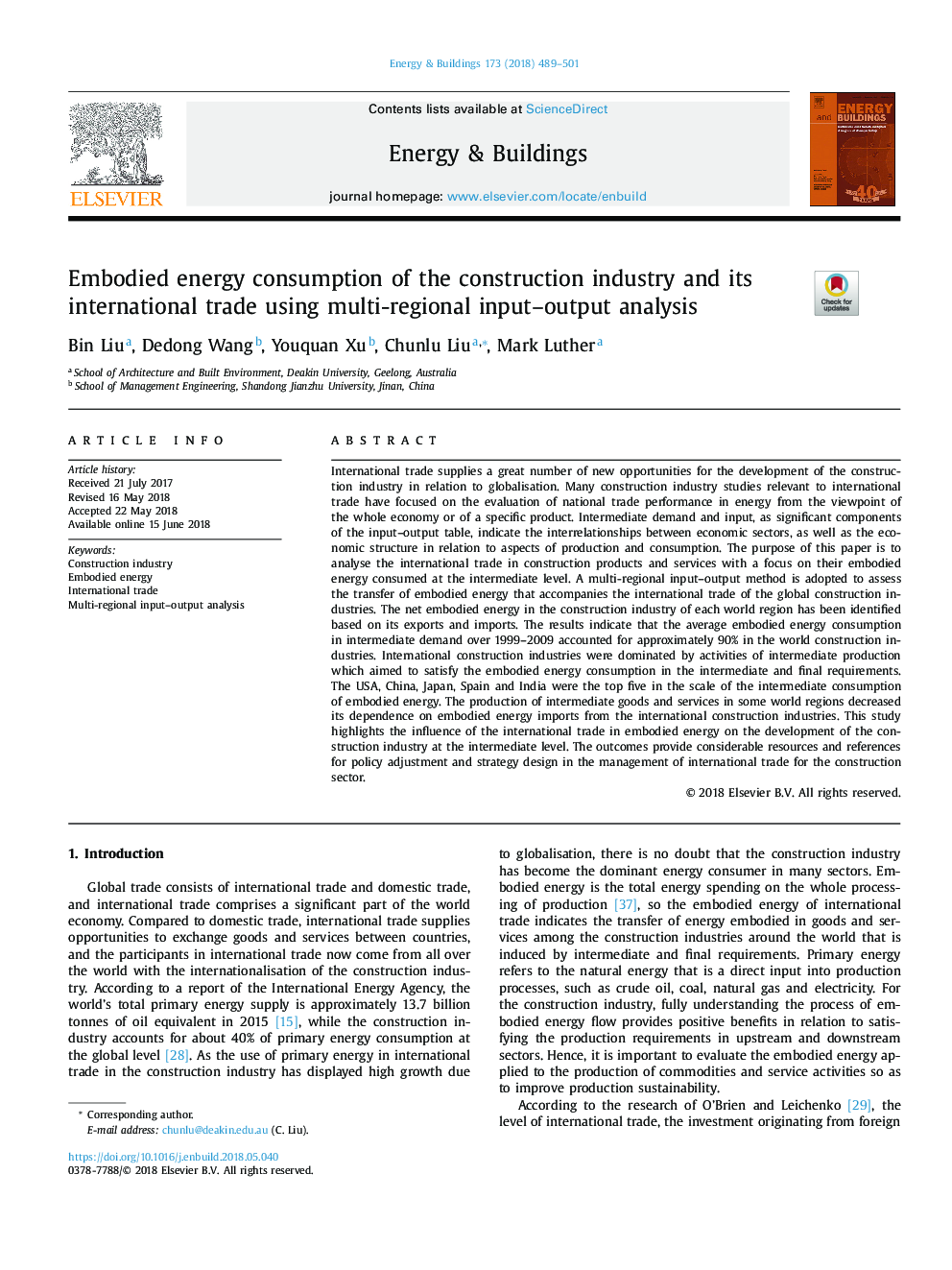| کد مقاله | کد نشریه | سال انتشار | مقاله انگلیسی | نسخه تمام متن |
|---|---|---|---|---|
| 6727624 | 1428917 | 2018 | 13 صفحه PDF | دانلود رایگان |
عنوان انگلیسی مقاله ISI
Embodied energy consumption of the construction industry and its international trade using multi-regional input-output analysis
ترجمه فارسی عنوان
مصرف انرژی مصرفی صنعت ساخت و ساز و تجارت بین المللی آن با استفاده از تحلیل ورودی-خروجی چند منطقه ای
دانلود مقاله + سفارش ترجمه
دانلود مقاله ISI انگلیسی
رایگان برای ایرانیان
کلمات کلیدی
صنعت ساخت و ساز، انرژی پر شده تجارت بین المللی، تجزیه و تحلیل خروجی ورودی چند منطقه ای،
ترجمه چکیده
تجارت بین المللی تعداد زیادی از فرصت های جدید برای توسعه صنعت ساخت و ساز در رابطه با جهانی شدن را فراهم می کند. بسیاری از مطالعات صنعت ساخت و ساز مربوط به تجارت بین الملل بر ارزیابی عملکرد تجاری ملی در انرژی از نظر اقتصاد کل یا یک محصول خاص متمرکز شده است. تقاضای متوسط و ورودی، به عنوان اجزای مهم جدول ورودی-خروجی، نشان دهنده رابطه بین بخش های اقتصادی و همچنین ساختار اقتصادی در رابطه با جنبه های تولید و مصرف است. هدف از این مقاله تجزیه و تحلیل تجارت بین المللی محصولات و خدمات ساخت و ساز با توجه به انرژی تجدید شده خود را مصرف شده در سطح متوسط است. روش ارزیابی ورودی-خروجی چند منطقه ای برای ارزیابی انتقال انرژی تجسمی که با تجارت بین المللی صنایع ساختمانی جهانی همراه است، اتخاذ می شود. انرژی خالص در صنعت ساخت و ساز منطقه هر منطقه بر اساس صادرات و واردات آن مشخص شده است. نتایج نشان می دهد که مصرف متوسط انرژی تجدید شده در تقاضای متوسط طی سال های 1999-2009 تقریبا 90٪ در صنایع ساخت و ساز در جهان را تشکیل می دهد. صنایع ساخت و ساز بین المللی تحت تاثیر فعالیت های تولید متوسط قرار گرفتند که هدف آن تامین انرژی تجدید پذیر در نیازهای متوسط و نهایی بود. ایالات متحده آمریکا، چین، ژاپن، اسپانیا و هند پنجمین کشور در مقیاس مصرف متوسط انرژی تجسم یافته بودند. تولید کالاهای و خدمات متوسط در برخی مناطق جهان وابستگی خود را به واردات انرژی تجسم شده از صنایع ساخت و ساز بین المللی کاهش داد. این مطالعه تأثیر تجارت بین المللی انرژی تجدید پذیر را در توسعه صنعت ساخت و ساز در سطح متوسط نشان می دهد. نتایج، منابع و ارجاعات قابل توجهی برای تنظیم سیاست و طراحی استراتژی در مدیریت تجارت بین المللی برای بخش ساخت و ساز ارائه می دهد.
موضوعات مرتبط
مهندسی و علوم پایه
مهندسی انرژی
انرژی های تجدید پذیر، توسعه پایدار و محیط زیست
چکیده انگلیسی
International trade supplies a great number of new opportunities for the development of the construction industry in relation to globalisation. Many construction industry studies relevant to international trade have focused on the evaluation of national trade performance in energy from the viewpoint of the whole economy or of a specific product. Intermediate demand and input, as significant components of the input-output table, indicate the interrelationships between economic sectors, as well as the economic structure in relation to aspects of production and consumption. The purpose of this paper is to analyse the international trade in construction products and services with a focus on their embodied energy consumed at the intermediate level. A multi-regional input-output method is adopted to assess the transfer of embodied energy that accompanies the international trade of the global construction industries. The net embodied energy in the construction industry of each world region has been identified based on its exports and imports. The results indicate that the average embodied energy consumption in intermediate demand over 1999-2009 accounted for approximately 90% in the world construction industries. International construction industries were dominated by activities of intermediate production which aimed to satisfy the embodied energy consumption in the intermediate and final requirements. The USA, China, Japan, Spain and India were the top five in the scale of the intermediate consumption of embodied energy. The production of intermediate goods and services in some world regions decreased its dependence on embodied energy imports from the international construction industries. This study highlights the influence of the international trade in embodied energy on the development of the construction industry at the intermediate level. The outcomes provide considerable resources and references for policy adjustment and strategy design in the management of international trade for the construction sector.
ناشر
Database: Elsevier - ScienceDirect (ساینس دایرکت)
Journal: Energy and Buildings - Volume 173, 15 August 2018, Pages 489-501
Journal: Energy and Buildings - Volume 173, 15 August 2018, Pages 489-501
نویسندگان
Bin Liu, Wang Dedong, Xu Youquan, Chunlu Liu, Mark Luther,
